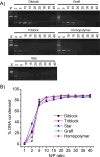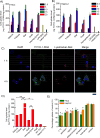Reconfiguring the architectures of cationic helical polypeptides to control non-viral gene delivery
- PMID: 23283350
- PMCID: PMC5951293
- DOI: 10.1016/j.biomaterials.2012.11.064
Reconfiguring the architectures of cationic helical polypeptides to control non-viral gene delivery
Abstract
Poly(γ-4-((2-(piperidin-1-yl)ethyl)aminomethyl)benzyl-l-glutamate) (PPABLG), a cationic helical polypeptide, has been recently developed by us as an effective non-viral gene delivery vector. In attempts to elucidate the effect of molecular architecture on the gene delivery efficiencies and thereby identify a potential addition to PPABLG with improved transfection efficiency and reduced cytotoxicity, we synthesized PEG-PPABLG copolymers with diblock, triblock, graft, and star-shaped architectures via a controlled ring-opening polymerization. The PPABLG segment in all copolymers adopted helical structure; all copolymers displayed structure-related cell penetration properties and gene transfection efficiencies. In HeLa and HepG-2 cells, diblock and triblock copolymers exhibited reduced membrane activities and cytotoxicities but uncompromised gene transfection efficiencies compared to the non-PEGylated homo-PPABLG. The graft copolymer revealed lower DNA binding affinity and membrane activity presumably due to the intramolecular entanglement between the grafted PEG segments and charged side chains that led to reduced transfection efficiency. The star copolymer, adopting a spherical architecture with high density of PPABLG, afforded the highest membrane activity and relatively low cytotoxicity, which contributed to its potent gene transfection efficiency that outperformed the non-PEGylated PPABLG and Lipofectamine™ 2000 by 3-5 and 3-134 folds, respectively. These findings provide insights into the molecular design of cationic polymers, especially helical polypeptides towards gene delivery.
Copyright © 2012 Elsevier Ltd. All rights reserved.
Figures







Similar articles
-
The effect of polymer architecture, composition, and molecular weight on the properties of glycopolymer-based non-viral gene delivery systems.Biomaterials. 2011 Aug;32(22):5279-90. doi: 10.1016/j.biomaterials.2011.03.082. Epub 2011 May 6. Biomaterials. 2011. PMID: 21529936
-
The effect of side-chain functionality and hydrophobicity on the gene delivery capabilities of cationic helical polypeptides.Biomaterials. 2014 Mar;35(10):3443-54. doi: 10.1016/j.biomaterials.2013.12.097. Epub 2014 Jan 15. Biomaterials. 2014. PMID: 24439403 Free PMC article.
-
Maximizing gene delivery efficiencies of cationic helical polypeptides via balanced membrane penetration and cellular targeting.Biomaterials. 2014 Jan;35(4):1302-14. doi: 10.1016/j.biomaterials.2013.09.090. Epub 2013 Nov 7. Biomaterials. 2014. PMID: 24211080 Free PMC article.
-
Cationic polymer optimization for efficient gene delivery.Mini Rev Med Chem. 2010 Feb;10(2):108-25. doi: 10.2174/138955710791185109. Mini Rev Med Chem. 2010. PMID: 20408796 Review.
-
[Advances in cationic polymers used as nonviral vectors for gene delivery].Sheng Wu Gong Cheng Xue Bao. 2013 May;29(5):568-77. Sheng Wu Gong Cheng Xue Bao. 2013. PMID: 24010355 Review. Chinese.
Cited by
-
Modular design and self-assembly of multidomain peptides towards cytocompatible supramolecular cell penetrating nanofibers.RSC Adv. 2020 Aug 10;10(49):29469-29474. doi: 10.1039/d0ra04748a. eCollection 2020 Aug 5. RSC Adv. 2020. PMID: 35521138 Free PMC article.
-
Enhanced Non-Viral Gene Delivery to Human Embryonic Stem Cells via Small Molecule-Mediated Transient Alteration of Cell Structure.J Mater Chem B. 2014;2(46):8098-8105. doi: 10.1039/C4TB00750F. J Mater Chem B. 2014. PMID: 26005572 Free PMC article.
-
Influence of histidine incorporation on buffer capacity and gene transfection efficiency of HPMA-co-oligolysine brush polymers.Biomacromolecules. 2013 Jun 10;14(6):1961-70. doi: 10.1021/bm400342f. Epub 2013 May 20. Biomacromolecules. 2013. PMID: 23641942 Free PMC article.
-
Polypeptides with quaternary phosphonium side chains: synthesis, characterization, and cell-penetrating properties.Biomacromolecules. 2014 Apr 14;15(4):1491-7. doi: 10.1021/bm5001026. Epub 2014 Mar 17. Biomacromolecules. 2014. PMID: 24635536 Free PMC article.
-
Nanoparticle Delivery of CRISPR/Cas9 for Genome Editing.Front Genet. 2021 May 12;12:673286. doi: 10.3389/fgene.2021.673286. eCollection 2021. Front Genet. 2021. PMID: 34054927 Free PMC article. Review.
References
-
- Paul A, Binsalamah ZM, Khan AA, Abbasia S, Elias CB, Shum-Tim D, et al. A nanobiohybrid complex of recombinant baculovirus and Tat/DNA nanoparticles for delivery of Ang-1 transgene in myocardial infarction therapy. Biomaterials. 2011;32:8304–18. - PubMed
-
- Giacca M, Zacchigna S. Virus-mediated gene delivery for human gene therapy. J Control Release. 2012;161:377–88. - PubMed
-
- Cho SK, Kwon YJ. Simultaneous gene transduction and silencing using stimuli-responsive viral/nonviral chimeric nanoparticles. Biomaterials. 2012;33:3316–23. - PubMed
Publication types
MeSH terms
Substances
Grants and funding
LinkOut - more resources
Full Text Sources
Other Literature Sources

